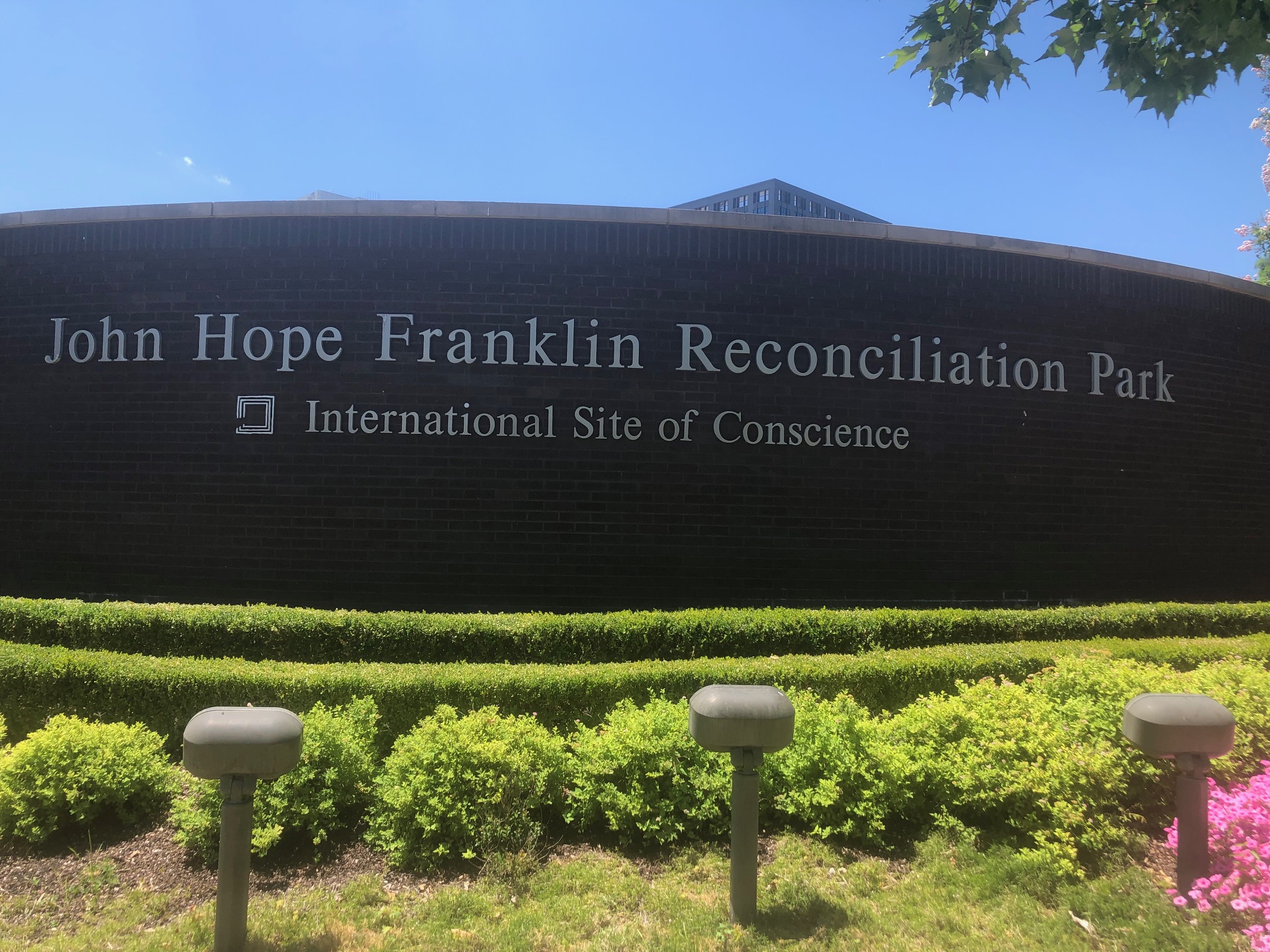The John Hope Franklin Reconciliation Park, on two and a half acres at the intersection of the African American community of Greenwood (Black Wall Street) and downtown Tulsa, is one of the most unusual parks in the United States. Situated in Tulsa, which currently has a population of 70,000, including 9,000 African American residents, the Park recalls one of the worst urban racial atrocities in the 20th century, the 1921 Tulsa Massacre.
To preserve a proper and complete recounting of events and to promote racial reconciliation in Tulsa, a group of corporations and private citizens planned to recognize John Hope Franklin’s contribution to history. Together, they created the John Hope Franklin Reconciliation Park at 321 North Detroit Avenue in Tulsa, Oklahoma. The locating of the Park on the edge of Deep Greenwood, the historically Black community destroyed during the Massacre, was a powerful and intentional reminder of the estimated 300 people killed and more than 10,000 residents made homeless in what was at the time one of the wealthiest and most educated African American communities in the nation. The term Black Wall Street was coined and given to this community by the renowned educator Booker T. Washington.
After the massacre, Black nurses and physicians pooled their resources and skills to set up a full-service hospital in North Tulsa with relief efforts provided by the American Red Cross. John Hope Franklin’s father, Buck Franklin, one of the attorneys in the region, immediately set up shop in the ruins of Deep Greenwood to provide legal services to the thousands of homeless residents.
The groundbreaking for this park was in 2008; a decade later, it was dedicated on May 31, 2018. The Reconciliation Park features Hope Plaza and the Tower of Reconciliation, the 26-foot-tall memorial tower surrounded by plaques that describe the history of the region going back to the days when Tulsa was on the boundary of the Creek and Cherokee nations to the present. Some of the memorial plaques include references to the enslaved Blacks who accompanied native people on the Trail of Tears in the 1830s, as well as descriptions of prominent Black citizens and institutions both before and after the Massacre.
This project, which grew out of the 2001 Oklahoma Commission to Study the Tulsa Race Riot of 1921, includes a bronze man armed for assault, a surrendering man with hands extended in the air, and a man holding a baby born June 1921. These designs were created by the renowned sculptor Edward Joseph Dwight Jr., the first African American astronaut.
Dr. John Hope Franklin, a Tulsa resident and a recipient of more than 130 honorary doctorates, was appointed to the Advisory Commission on Public Diplomacy in 1979 by President Jimmy Carter, awarded the Presidential Medal of Freedom by President Bill Clinton in 1995, and served on Clinton’s Advisory Board for the President’s Initiative on Race from 1997 to 1998. Also, in 2007, Franklin was recognized with the Fulbright Association’s Fulbright Lifetime Achievement Award as a Fulbright Scholar in Australia, Brazil, the United Kingdom, Venezuela, and Zimbabwe, and served as Chair of the Fulbright Foreign Scholarship Board for three years.
In June 2020, the John Hope Franklin Reconciliation Park became part of the African American Civil Rights Network (AACRN), a collection of properties, facilities, and programs that offers a comprehensive overview of the people, places, and events associated with the African American civil rights movement office entrusted through an official order and created by the African American Civil Rights Act of 2017.
Do you find this information helpful? A small donation would help us keep this available to all. Forego a bottle of soda and donate its cost to us for the information you just learned, and feel good about helping to make it available to everyone.
BlackPast.org is a 501(c)(3) non-profit and our EIN is 26-1625373. Your donation is fully tax-deductible.
“John Hope Franklin Reconciliation Park: From Tragedy to Triumph,” https://www.jhfcenter.org/reconciliation-park;
Malik Simba, “John Hope Franklin (1915-2009),” https://www.blackpast.org/african-american-history/john-hope-franklin-1915/
Herb Ruffin, “We Can Best Honor Our Past by Not Burying It: The Tulsa Race Massacre of 1921,” https://www.blackpast.org/african-american-history/perspectives-african-american-history/we-can-best-honor-our-past-by-not-burying-it-the-tulsa-race-massacre-of-1921

